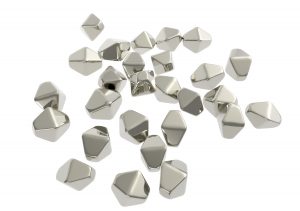
Depiction of titanium dioxide nanoparticles.
In two recent developments, titanium dioxide (TiO2) is driving advances in solar power generation and cameras and optical devices for virtual and augmented reality. Chlorine facilitates the production of TiO2 by transforming and purifying the materials.
Heat transfer in solar power plants could be made dramatically more efficient using nanofluids made with TiO2, reports Phys.org. A recent paper in the Renewable Energy journal describes a way to improve the efficiency of this heat transfer by adding tiny particles of titanium dioxide. Known as nanoparticles, these increase the amount of electricity generated from solar plants. Thanks to the titanium dioxide nanoparticles, the ability of the heat-transfer material to conduct heat rose by almost 53%, and the efficiency of the nanofluids improved by up to 35%.
In the second innovation, TiO2 has been used to make a distortion-free lens with a simple, flat surface, which may revolutionize optical devices (Nature Nanotechnology). Using tiny, fin-shaped particles of TiO2 known as nanofins, this can focus the full spectrum of visible light at high resolution on one spot, which previously required a stack of bulky, curved conventional lenses. These were required because light of various colors travels at different speeds through lenses. The new ‘metalens’ – which is reportedly thin, easy to manufacture and cost effective – opens new possibilities both in traditional cameras and in virtual and augmented reality (Photonics.com).